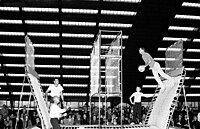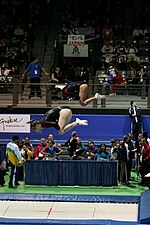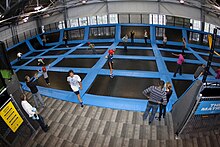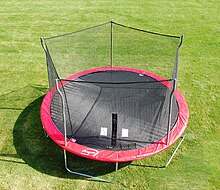Trampoline: Difference between revisions
Good faith revert of edit(s) by 74.102.129.25 using STiki |
|||
| Line 12: | Line 12: | ||
The 19th-century poster for [[Pablo Fanque]]'s Circus Royal references performance on trampoline, though the device is thought to have been more like a springboard than the fabric-and-coiled-springs apparatus presently in use.<ref>[http://www.sideshowworld.com/a/at/atskite.html Sideshow World, and Sideshow Performers from around the world.]</ref> |
The 19th-century poster for [[Pablo Fanque]]'s Circus Royal references performance on trampoline, though the device is thought to have been more like a springboard than the fabric-and-coiled-springs apparatus presently in use.<ref>[http://www.sideshowworld.com/a/at/atskite.html Sideshow World, and Sideshow Performers from around the world.]</ref> |
||
| ⚫ | WOOP WOOP!these may not be the true antecedents of the modern sport of trampolining, but indicate that the concept of bouncing off a fabric surface has been around for some time. In the early years of the 20th century, some acrobats used a "bouncing bed" on the stage to amuse audiences. The bouncing bed was, in reality, a form of small trampoline covered by bedclothes, on which acrobats performed mostly [[comedy]] routines. |
||
| ⚫ | |||
According to [[Circus (performing art)|circus]] folklore, the trampoline was supposedly first developed by an artiste named du Trampolin, who saw the possibility of using the trapeze safety net as a form of propulsion and landing device and experimented with different systems of suspension, eventually reducing the net to a practical size for separate performance. While trampoline-like devices were used for shows and in the circus, the story of du Trampolin is almost certainly apocryphal, and no documentary evidence has been found to support it. |
According to [[Circus (performing art)|circus]] folklore, the trampoline was supposedly first developed by an artiste named du Trampolin, who saw the possibility of using the trapeze safety net as a form of propulsion and landing device and experimented with different systems of suspension, eventually reducing the net to a practical size for separate performance. While trampoline-like devices were used for shows and in the circus, the story of du Trampolin is almost certainly apocryphal, and no documentary evidence has been found to support it. |
||
Revision as of 14:07, 27 April 2012

A trampoline is a device consisting of a piece of taut, strong fabric stretched over a steel frame using many coiled springs. People bounce on trampolines for recreational and competitive purposes.
The fabric on which users bounce (commonly known as the 'bounce mat' or 'trampoline bed') is not elastic in itself; the elasticity is provided by the springs that connect it to the frame.
History
Early trampoline-like devices
A game similar to trampolining was developed by the Inuit, who would toss each other into the air on a walrus skin (see Nalukataq). There is also some evidence of people in Europe having been tossed into the air by a number of people holding a blanket; Mak in the Wakefield Second Shepherds' Play and Sancho Panza in Don Quixote are both subjected to blanketing – however, these are clearly non-voluntary, non-recreational instances of quasi-judicial, mob-administered punishment. The trampoline-like life nets once used by firemen to catch people jumping out of burning buildings were invented in 1887.
The 19th-century poster for Pablo Fanque's Circus Royal references performance on trampoline, though the device is thought to have been more like a springboard than the fabric-and-coiled-springs apparatus presently in use.[1]
WOOP WOOP!these may not be the true antecedents of the modern sport of trampolining, but indicate that the concept of bouncing off a fabric surface has been around for some time. In the early years of the 20th century, some acrobats used a "bouncing bed" on the stage to amuse audiences. The bouncing bed was, in reality, a form of small trampoline covered by bedclothes, on which acrobats performed mostly comedy routines.
According to circus folklore, the trampoline was supposedly first developed by an artiste named du Trampolin, who saw the possibility of using the trapeze safety net as a form of propulsion and landing device and experimented with different systems of suspension, eventually reducing the net to a practical size for separate performance. While trampoline-like devices were used for shows and in the circus, the story of du Trampolin is almost certainly apocryphal, and no documentary evidence has been found to support it.
First modern trampolines
The first modern trampoline was built by George Nissen and Larry Griswold in 1936.[2] Nissen was a gymnastics and diving competitor and Griswold was a tumbler on the gymnastics team, both at the University of Iowa, USA. They had observed trapeze artists using a tight net to add entertainment value to their performance and experimented by stretching a piece of canvas, in which they had inserted grommets along each side, to an angle iron frame by means of coiled springs. It was initially used to train tumblers but soon became popular in its own right. Nissen explained that the name came from the Spanish trampolín, meaning a diving board. George Nissen heard the word on a demonstration tour in Mexico in the late 1930s and decided to use an anglicized form as the trademark for the apparatus.[3]
In 1942, Griswold and Nissen created the Griswold-Nissen Trampoline & Tumbling Company, and began making trampolines commercially in Cedar Rapids, Iowa.
The generic term for the trademarked trampoline was a rebound tumbler[4] and the sport began as rebound tumbling. It has since lost its trademark and has become a generic trademark.

Early in their development Nissen anticipated trampolines being used in a number of recreational areas, including those involving more than one participant on the same trampoline. One such game was Spaceball—a game of two teams of two on a single trampoline with specially constructed end "walls" and a middle "wall" through which a ball could be propelled to hit a target on the other sides end wall.[5]
Use in flight and astronaut training
During World War II, the United States Navy Flight School developed the use of the trampoline in its training of pilots and navigators, giving them concentrated practice in spatial orientation that had not been possible before.[6] After the war, the development of the space flight programme again brought the trampoline into use to help train both American and Soviet astronauts, giving them experience of variable body positions in flight.
Competitive sports

One of the earliest pioneers of trampoline as a competitive sport was Jeff Hennessy, a coach at the University of Louisiana at Lafayette. Hennessy also coached the United States trampoline team, producing more world champions than any other person. Among his world champions was his daughter, Leigh Hennessy. Both Jeff and Leigh Hennessy are in the USA Gymnastics Hall of Fame.
The competitive gymnastic sport of trampolining has been part of the Olympic Games since 2000. On a modern competitive trampoline, a skilled athlete can bounce to a height of up to 10 metres (33 ft), performing multiple somersaults and twists. Trampolines also feature in the competitive sport of Slamball, a variant of basketball, and Bossaball, a variant of volleyball.
Cross-training for other sports
There are a number of other sports that use trampolines to help develop and hone acrobatic skills in training before they are used in the actual sporting venue. Examples can be found in diving, gymnastics, and freestyle skiing.
Construction
There are two generic types of trampoline, competitive and recreational.
Competitive
The frame of a competitive trampoline is made of steel and can be made to fold up for transportation to competition venues. The trampoline bed is rectangular 4.28 by 2.4 metres (14 ft 1 in × 7 ft 10 in) in size[7] fitted into the 5.2 by 3.05 metres (17 ft × 10 ft) frame with around 110 steel springs (the actual number may vary by manufacturer). The bed is made of a strong fabric, although this is not itself elastic; the elasticity is provided only by the springs. The fabric can be woven from webbing, which is the most commonly used material. However, in the 2007 World Championships held in Quebec City, a Ross (or "Two-String") bed, woven from individual thin strings, was used. This type of bed gives a little extra height to the rebound.
Recreational

Home trampolines
Recreational trampolines for home use are less sturdily constructed than competitive ones and their springs are weaker. They may be of various shapes, though most are circular, octagonal or rectangular. The fabric is usually a waterproof canvas or woven polypropylene material.
As with competitive trampolines, recreational trampolines are usually made using coiled steel springs to provide the rebounding force. New Zealander Dr. Keith Vivian Alexander of the University of Canterbury designed a trampoline that replaces the springs with cantilevered pultruded fibreglass rods to provide the rebounding force. This Springfree trampoline design allows the steel jumping frame to be placed below the jumping plane, ostensibly improving the user's safety.[8]
Commercial trampoline parks

In 1959 and 1960 it became very popular to have outdoor commercial "jump centres" or "trampoline parks" in many places in North America where people could enjoy recreational trampolining. However, these tended to have a high accident rate and the public's interest rapidly waned.[9] In recent years, indoor commercial trampoline parks have made a come-back with a number of franchises set up across the United States and Canada. These are located indoors. They have wall to wall trampolines to prevent people falling off the trampolines on to hard surfaces. There are padded or spring walls to protect people from impact injuries. Despite these precautions there has been at least one death recorded due to a bad head first landing at a trampoline park. [10] In March 2012, New York Yankees pitcher Joba Chamberlain seriously injured his ankle while jumping at a commercial jump centre in Tampa with his son.[11]
Safety

Using a trampoline can be dangerous, and in organized clubs and gyms there are usually large safety end-decks with foam pads at each end and spotters placed alongside the trampoline to try to break the fall of any athlete who loses control and falls. The majority of injuries happen on privately owned home trampolines. Bouncing off a trampoline can result in a fall of 3–4 metres (10–13 ft) from the peak of a bounce to the ground or a fall into the suspension springs and frame. There has been an increase in the number of home trampolines in recent years and a corresponding increase in the number of injuries reported, leading some medical organizations to suggest that they be banned.[12]
Authorities recommend that only one person should be allowed to jump at a time to avoid collisions and people being catapulted in an unexpected direction or higher than they expect. In fact, one of the most common sources of injury is when there are multiple users bouncing on the trampoline at one time. More often than not, this situation leads to users bouncing into one another and thus becoming injured; many suffer broken bones as a result of landing strangely after knocking into another user.
Another of the most common sources of serious injury is an attempt to perform somersaults without proper training. In some cases, people land on their neck or head, which can cause paralysis or even death. A famous incident in the 1960s paralyzed pole-vaulting champion Brian Sternberg from the neck down.
Danger can be reduced by burying the trampoline so the bed is closer to the surrounding surface to lessen falling distance, and padding that surrounding area. Pads over the spring and frame reduce the severity of impact injuries. Keeping the springs covered also reduces the risk of a limb falling between the gaps in the springs and the rest of the body falling off of the trampoline. This is the most common injury of all.[citation needed]
Kits are available for home trampolines that provide a retaining net around the trampoline and prevent users from bouncing over the edge. While these nets do prevent jumpers falling off the trampoline onto the ground, these falls are not the most common source of injury and multiple users bouncing in a netted trampoline can still be injured. This would have a larger benefit for safeguarding solo trampolinists, so long as they avoid falling on their head/neck.
Having some training in a gym may be beneficial in alerting people to possible hazards and provide techniques to avoid bad falls.[13]
Overall the safest type of home trampoline to have would be a circle. A user's bounce will tend to propel them where the springs point . Since the round trampoline has all springs pointing to the center and at each other, the natural forces will attempt to centre the user.[citation needed]
Mini-trampolines
A mini-trampoline (also known as a rebounder, trampette, jogging trampoline, or exercise trampoline) is less than 1 metre (3 ft 3 in) in diameter and about 30 centimetres (12 in) off the ground, often kept indoors and used as part of a physical fitness regime. So-called rebounding provides a form of exercise with a low impact on knees and joints. Mini-trampolines do not give a rebound as high as larger recreational or competitive trampolines.
Educational use
In co-operation with the University of Bremen and the German Aerospace Center (DLR), the machtWissen.de Corporation from Bremen, Germany developed the weightlessness demonstrator “Gravity Jumper” based on a trampoline. Due to the acceleration during the jump, an acceleration force takes effect in addition to the usual gravitational force. Both forces add up and the person on the trampoline seems to become heavier. As soon as the jumper leaves the trampoline, he is under a free fall condition. Physically speaking, gravitation and inert force compensate completely, which means that the jumper is weightless. Every person receives a three-axis acceleration sensor, fastened to them with a belt. The sensor transmits the data of the flight path to a monitor; a monitor shows the course of the acceleration, including the zero gravity phase. The interplay of acceleration and microgravity becomes apparent.
References
- ^ Sideshow World, and Sideshow Performers from around the world.
- ^ WestView Trampoline Community site - Trampoline History p. 3
- ^ "Inventor of the Week Archive - George Nissen". Massachusetts Institute of Technology, MIT School of Engineering. 2004. Retrieved 2007-04-13.
{{cite web}}: Cite has empty unknown parameter:|coauthors=(help); Unknown parameter|month=ignored (help) - ^ A Sportswriter's Life By Gerald Eskenazi pg. 125
- ^ "Trampoline history".
- ^ WestView Trampoline Community site - Trampoline History p.4
- ^ FIG Trampoline Rules
- ^ Description of US patent 6319174 from Patentstorm.us, retrieved 29 August 2007.
- ^ West View Trampoline Community site - Trampoline History p. 19
- ^ Man dies from Trampoline Park injury
- ^ New York Daily News - Joba’s a pitcher of calm on 911 tape
- ^ Science Daily - Trampoline injuries
- ^ Consumer Affairs - Trampoline Safety
